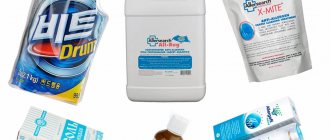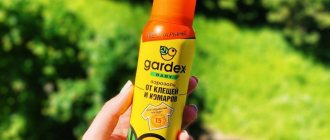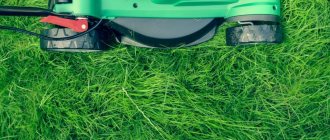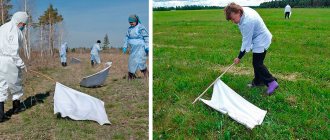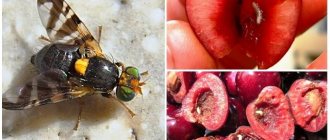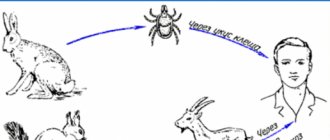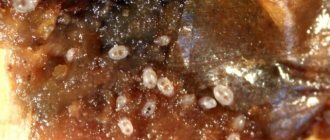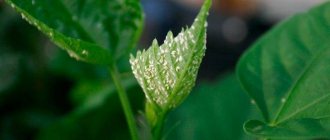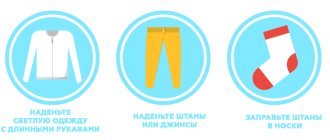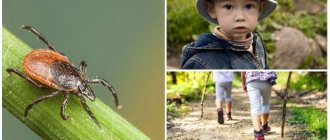People have been trying to fight ticks for a very long time, but so far they have not been able to achieve decisive success in this field, despite the fact that new, more and more advanced means and methods are regularly appearing.
Treatment against ticks is called acaricidal, since it is carried out using acaricides - special chemicals. There are many varieties of these substances, which differ in the principle of action and form of release.
- 8.1 Treatment of areas
What are acaricides?
Acaricidal agents are drugs used to combat ticks. The effect of a particular product is determined by the chemical or biological compounds it contains. The drugs are available in the form:
- aerosols and sprays;
- solutions;
- powders;
- granules;
- emulsions;
- concentrates;
- paste;
- smoke bombs.
Aerosols
Acaricides are used against ticks of all types, promoting their rapid destruction and preventing their re-spread.
Fungicides
These drugs are designed to destroy parasitic fungi. Fungicides save plants from powdery mildew, downy mildew, various rots, spots and other diseases.
Triazoles
These are long-lasting, systemic (penetrate into the plant) and broad-spectrum drugs. The active substances in their composition are able to move beyond the growth point of the plant and protect young growths from fungi. Triazoles are quickly absorbed by leaves and are recommended against powdery mildew, rot, rust, scab, septoria, and oidium. But for the treatment of fusarium they are ineffective.
| A drug | active substance |
| Score | difenoconazole |
| Topaz | penconazole |
| Impact | flutriafol |
| Vectra | Bromuconazole |
| Byleton | triadimefon |
| Tilt | propiconazole |
| Shavit | triadimenol, folpet |
Benzimidazoles
Fungicides of this class suppress the processes of nuclear division in fungal cells. The active ingredients are well absorbed by plants through the roots and spread upward through the vascular system. The preparations are used when watering the soil, as well as for treating seeds.
According to reviews from experienced gardeners, benzimidazoles are the best fungicides for combating root rot of plants. In addition, only these drugs can effectively combat fusarium.
| A drug | active substance |
| Derosal | carbendazim |
| Fundazol | benomyl |
| Topsin-M | thiophanate-methyl |
Of all the benzimidazoles, thiabendazole lingers in the soil the longest - from 500 to 724 days. And, for example, carbendazim decomposes much faster - from 20 to 40 days.
Strobilurins
The drugs have a systemic and immunostimulating effect. Their active ingredients are resistant to temperature changes, are able to move beyond the plant’s growth point and provide protection to young shoots. Strobilurins are used against powdery mildew, rot, rust, scab, downy mildew, late blight, mildew and leaf spot. Ineffective for the treatment of fusarium.
| A drug | active substance |
| Strobe | kresoxim-methyl |
| Flint | trifloxystrobin |
| Quadris | azoxystrobin |
| convertible top | piaclostrobin |
Hydroxyanilides
This is a fairly new class of fungicides that have a systemic and protective effect. They are intended mainly to combat gray and monilial rot, powdery mildew.
The active ingredient is fenhexamide, the most popular drug of this class is Teldor. It is not phytotoxic, not dangerous to humans and the environment, and is ideal for processing flowers.
Carbamates
Carbamates also have a systemic effect: they penetrate through the roots and are distributed throughout the vessels of the entire plant. But they are used only for the prevention of fungal diseases, since they are not able to cure infected specimens.
The most famous drug of this class is Previkur. The active substance is propamocarb.
Piperazine derivatives
They have a protective and healing effect. Effective only against powdery mildew, gray rot, scab and oidium. The active ingredient is triforin. The chemical is called Saprol.
Pyrimidineamines
They have a systemic or limited systemic effect. The drugs are used in the fight against scab, powdery mildew and moniliosis. Gardeners and gardeners most often use the drug Horus (active ingredient - cyprodinil).
Imidazoles
These drugs only treat diseases that are easily treatable. For example, with powdery mildew. In other cases, imidazoles are effective only for prevention. The most popular drug is Spartak (the active ingredient is prochloraz).
Dithiocarbamates
These fungicides have limited contact action. They are effective only for intermediate, final and preventive treatments.
| A drug | active substance |
| Polycarbacin | polishers, meterers |
| Ditan M-45, Acrobat MC | mancozeb, dimethomorph |
| Antrakol | propineb |
| Ridomil Gold | mancozeb, metalaxyl |
Acetamides and oxazolidine derivatives
Effective against late blight, alternaria and mildew. The combination drug Thanos is usually used. The active ingredients are cymoxanil and famoxadone.
Copper-based preparations
There are many copper-containing fungicides, but copper sulfate and Oksikhom are most often used. They have a limited contact effect and are used for the prevention and treatment of superficial fungal diseases. But keep in mind: copper-based preparations are phytotoxic.
There are other classes of fungicides, but these drugs are almost never used in gardening.
Operating principle
The general principle of operation of an acaricide is the effect of a toxic active substance on the nervous system of the parasite, followed by paralysis, failure of internal organs and death. According to the mechanism of action, acaricidal drugs can be divided into several groups:
- contact - the parasite dies after the toxic substance gets on its outer integument;
- intestinal – enter the body through the digestive system;
- enteric contact - more effective means that combine the properties of the previous two;
- fumigants - toxic vapors penetrate the respiratory system;
- systemic - quickly absorbed into the plant tissue, and then poison the mites parasitizing on it.
Depending on the acaricidal effect of a particular product, the method and frequency of its use changes.
Dust mites - how to deal with them
Microscopic arthropods that live in upholstered furniture, toys, curtains, and bedding have a size of only 0.1-0.5 mm. They are synanthropic parasites that live near people. Dust mites love warmth (20-250) and high humidity. Arachnids feed on dead pieces of skin. An allergic reaction of varying degrees of intensity is caused by parasite excrement. They cause:
- dermatitis;
- conjunctivitis;
- bronchial asthma;
- allergic rhinitis.
Attention. To get rid of dust mites, a systematic approach is required: wet cleaning, reducing wool carpets, soft toys, feather-based bedding to a minimum, and using acaricides when washing.
Among the large number of substances that can destroy the parasite, benzyl benzoate is the most widespread. The most popular acaricidal preparations against mites in house dust are:
Allergoff
Allergoff is a spray that helps destroy domestic ticks at any stage of their development. Active ingredients: permethrin, pyriproxyfen, benzibenzoate. The composition has a long lasting effect and is safe for humans and pets. The product has a neutral odor and does not leave stains on fabric or other surfaces. The spray has active components that penetrate the digestive system and lead to the death of parasites. The components of the drug glue the tick secretions, preventing them from flying through the air.
Environmental Resistance
Most acaricides are destroyed fairly quickly when exposed to weather conditions. They are affected by precipitation, air temperature, and wind. For example, the hotter it is outside, the shorter the duration of the drug. That is why the products used to treat premises remain effective longer than those used to treat the area.
Treatment of the area
Insectoacaricides
This is a fairly large group of drugs that are biological or chemical in nature. They are classified according to mechanical impact:
- Contact – lead to the death of pests upon contact with any part of the body.
- Intestinal - act when they enter the body of insects along with food.
- Fumigants - the destruction of parasites occurs due to poisoning by vapors that penetrate their respiratory organs.
- Systemic - these drugs move through the vessels of plants and cause the death of parasites that eat them.
Benefits of organophosphates:
- extensive effects on insects;
- high efficiency;
- quickly decompose and are not stored in the soil;
- there is no accumulation in the cellular tissues of the body, metabolism proceeds at a good speed;
- have a slight toxic effect on fish;
- have an active and rapid effect on harmful parasites.
Impact on the environment, people and pets
The danger of an acaricide against ticks for people, animals, beneficial insects and the environment is determined by the combination and concentration of substances in its composition. All acaricides belong to one of 4 toxicity classes:
- Class 1 – extremely toxic;
- Class 2 – highly toxic;
- Class 3 – moderately toxic;
- Class 4 – low toxic.
Substances belonging to class 1 can only be used by properly trained professionals, while class 4 acaricides do not pose a threat to the health of people, animals, insects, fish and plants.
Composition and purpose
The name “acaricides” comes from 2 words: acari (mite) and cide (reduce), which translated means a means that reduces the number of ticks. It is these drugs that are used to destroy “bloodsuckers” on plants, indoors, city parks and forests.
Experts consider ticks to be the most dangerous parasites due to their ability to become carriers of severe infections:
- encephalitis, which severely affects the condition of the central nervous system and the entire human body;
- Lyme disease (borreliosis), which is chronic and affects many human systems: heart, blood vessels, nervous system, etc.).
That is why the territory is regularly treated with special preparations to preserve the health and lives of people and animals.
On a note!
The main substances included in acaricides against ticks are chemical compounds of phosphorus, chlorine, sulfur and mineral oils.
Classification of acaricides
All acaricides are divided into 3 large groups:
- acarofungicides - used to kill mites and pathogenic fungi;
- insectoacaricides – act on ticks and insects;
- specific acaricides are narrowly targeted drugs that affect only arachnids.
For a person planning to start fighting ticks, it is very important to determine the specific type of parasites in order to choose the most effective remedy.
Insectoacaricides
Insectoacaricides are a large group of combined drugs that destroy arachnids and other insects. Most of these products are highly toxic, which is why a quick effect is achieved. Often, parasites and pests quickly develop resistance to a particular drug, so the products must be changed regularly.
Organophosphorus compounds
This category includes derivatives of pentavalent phosphorus, which quickly penetrate the body of parasites and affect the nervous system, stopping the transmission of nerve impulses. As a result, the functioning of internal organs ceases and death occurs. The drugs are low toxic, but effectively destroy larvae and adults.
Avermectins
This is a group of biological substances that are synthesized based on the waste products of soil fungi. Avermectins are used in the fight against plant mites, insect pests, and some types of nematodes. But these drugs do not work on ixodids - carriers of tick-borne encephalitis and other dangerous diseases.
Mite
Amidines
These organic compounds are based on nitrogen-containing derivatives of carboxylic acids. Amidines are contact agents that ensure rapid death of arachnids. In addition, they have a repellent effect, so they are often used to protect pets (drops on the withers, impregnation for collars). The advantages include the low probability of development of resistance in parasites.
Pyrethroids
This group includes synthetic substances that are substitutes for the natural insecticide pyrethrin. These are contact agents that quickly penetrate the pest’s body through the outer integument and cause paralysis and death. This category of acaricidal drugs is used to protect domestic animals and crops from ticks and harmful insects.
Acarofungicides
Acarofungicides are used to combat arachnids and pathogenic fungi. The products are quite effective, but have a big drawback - being quite toxic, they destroy many types of beneficial insects.
Specific acaricides
This category of drugs is highly specific and affects only arachnids. The use of specific acaricides destroys not only adults and larvae, but also negatively affects tick eggs.
Sulfur-containing drugs
Products containing sulfur are characterized by a rapid effect on arachnid parasites and are relatively safe for people and animals. Most sulfur-containing preparations destroy ticks at any stage of development. In addition to mites, products with sulfur are destructive to pathogens of fungal diseases, so they are often used to treat plants.
Types of ticks
Scientists have found and studied 50,000 species of ticks, most of them do not pose a danger to humans. Small parasites do not belong to insects - they are animals of the arachnid class. Among the species that cause the greatest harm to people, it is worth highlighting several that have become particularly widespread:
- Ixodid tick - representatives of this family are carriers of a dangerous disease - encephalitis. It is impossible to identify an infected individual by external signs. The parasite lives in the forest and has a hard chitinous shell. Adults cling tightly to clothing, then crawl in search of an open area of the body.
Ixodid ticksAttention. In addition to encephalitis, forest ticks also carry other diseases: typhus, Lyme syndrome, tick paralysis.
- The Argas soft tick lives in caves, cracks in walls, burrows and other secluded places. The arachnid sucks blood, causing dermatitis, and spreading infections.
- Gamasid species - lives on birds and mammals (rats, mice). It is dangerous for humans if there is no other food source nearby. Has toxic saliva.
- Bed mite - settles in accumulations of feathers or dust, feeding on dead epidermis. The parasite does not live on humans; the main danger is its excrement. The individual's waste products include a potent allergen.
- Spider mite - this species parasitizes plants, entwining them with a dense web and drinking the sap. The pest is not dangerous to humans, but a large population of individuals can cause plant death. Treatment with acaricides against mites helps preserve the crop.
Instructions for the use of acaricides
In order for the use of acaricide to be as effective as possible, it is necessary to follow some recommendations regarding the timing of the procedure, preparation for it, and the nuances of the procedure. It is very important to understand that such an event as acaricidal treatment should be carried out only in personal protective equipment and in compliance with safety rules.
Treatment of areas
When planning to destroy ticks in your summer cottage, you must adhere to the following rules:
- for acaricidal treatment, you should choose a windless day without precipitation, the best time is early morning or late evening;
- it is optimal to apply insectoacaricides twice a year - in the spring before planting and in the fall after harvesting;
- It is advisable to remove tools and garden furniture from the area, close water containers, and take away children and pets for 2–3 days.
When acaricidal treatment of a household area is carried out, not only the soil and grass are sprayed, but also shrubs and trees at a height of up to 1.2 - 1.5 m.
Use of acaricidal agents in enclosed spaces
When using acaricides indoors, you must be especially careful and follow some recommendations:
- remove dishes, food, personal belongings, laundry;
- children, animals, and strangers should not be present during processing;
- It is necessary to treat the entire room, paying special attention to hard-to-reach places.
- During the procedure, you must close all windows and doors, and after the time specified in the instructions, thoroughly ventilate the room.
Wet cleaning
After treatment, be sure to carry out wet cleaning using a soap or soda solution.
Allergoff® laundry additive
Anti-allergic acaricidal additive for washing, intended for hand or machine washing at temperatures up to 60 degrees. A single use of the ALLERGOFF® additive protects your laundry from ticks for up to 3 months. Also recommended for washing animal bedding. If the instructions for use are followed, no harmful residual substances remain after washing.
Active Ingredients:
30% benzyl benzoate. 19.9% Benzyl alcohol. 0.1% Reriproxyfen. Contains 7 sachets of 20 ml, consumption for machine washing is 1 sachet, for hand washing - 1 sachet per 20 liters of water.
Handwash:
1. Dilute the contents of one package in 20 liters of water. 2. Soak the laundry for 2 hours 3. Add washing powder or other regular laundry detergent, continue washing and rinsing as usual. 4. Do not use as a rinse aid. 5. Undiluted concentrate should not be applied directly to dry clothing. 6. Do not allow the concentrate to come into contact with the skin or mucous membranes.
Machine washable:
1. Set the pre-wash program.
After soaking the laundry, add the contents of one sachet directly into the machine drum, and after mixing, turn off the machine for two hours. Do not add the product to the rinse aid compartment of the washing machine. Website - catalog of individual women: prostitutes Ufa Intimate leisure for men 2. Add washing powder or other regular laundry detergent, continue washing and rinsing as usual. The drug was developed by specialists from PESTINOVA R&D CENTER and tested in the laboratory of THE LONDON SCHOOL OF HYGIENE AND TROPICAL MEDICINE. Manufacturer:
ICB PHARMA ALLERGOFF® is a registered trademark of ICB PHARMA.
The best modern drugs
It is almost impossible to choose the best drug from the entire list of acaricides, since you have to take into account too many factors. It all depends on what problem needs to be solved, who exactly is the pest, and where the product will be used. But there are several drugs that have earned many positive reviews from both ordinary users and specialists. Among them:
- Gardex is an aerosol for protection against ixodid ticks, used for treating outer clothing and equipment;
- Dr. Klaus is an insectoacaricide of enteric contact action, used to combat many types of pests and parasites;
- Medilis-cyper is an insectoacaricide of enteric contact action based on cypermethrin, used for treating areas;
- Masai is a contact-systemic acaricide for protecting plants from mites; it acts on parasites at any stage of development;
- Appolo is a highly specialized product designed to destroy spider mites and red fruit mites and is used to treat horticultural crops;
- Oberon is an insectoacaricide for the protection of garden and indoor plants; in addition to mites, it affects thrips and whiteflies;
- Akarosan is a drug against dust mites, used to treat upholstered furniture, has a long shelf life;
- Milbiol is an acaricidal agent with a high content of plant components, used to combat dust mites.
If choosing the right drug may be difficult, you should seek help from a consultant in the store.
Remedies against ixodid parasites
The most convenient form of acaricidal preparations for ixodid ticks are sprays and aerosols. They process clothing and camping equipment before going into the forest. For animals that are also targets for predatory arthropods, drops and collars containing a repellent are recommended.
Gardex
Aerosol acaricide Gardex is applied to clothing, backpacks, tents and other fabric surfaces. The use of 2nd generation pyrethroids makes the product effective against parasites and safe for humans. Upon contact with an acaricidal compound, after 10-15 minutes the tick loses its ability to cling and stick, and complete paralysis occurs. The effect of the product lasts on fabric for up to 15 days.
Taiga Antiklesch
Spray for protection against ixodid ticks, which carry deadly diseases. The substance is applied to clothing, curtains, and mosquito nets. It is recommended to carry out the treatment outdoors or in a well-ventilated area. One application is enough for 2 weeks or until washing. To spray clothes, 25 ml of the drug is enough. Do not use on people, the composition (neonol, alphacypermethrin) is toxic.
Attention. Repellent preparations do not kill ticks, but only repel them. Such products can be applied not only to clothing, but also to human skin. Their action is quite effective, but during the peak season the drugs will not prevent the bite of a hungry parasite.
Sumi alpha
Sumi-alpha, 5% E. Pyrethroid drug. Toxic to many sucking and chewing pests. Recommended for spraying pome fruits (apple, pear, quince), grapes and cruciferous crops (cabbage, radish, radish) at a concentration of 5 g per 10 liters of water. The drug is sprayed once. Waiting period - 30 days (grapes - 45 days). Pome crops are sprayed against the apple flower beetle (during the green cone phase), leaf rollers, moths, aphids, scale insects, apple sawfly, goose, codling moth, California scale insect (after flowering).
On grapes, the drug is used during the separation of buds in inflorescences against grape budworm and grape moth. On cabbage and other cruciferous vegetables, the drug is used before the head is planted to destroy cruciferous flea beetles, cabbage moths, armyworms, aphids, flies, whiteflies, sawflies, and bedbugs. Potatoes are sprayed against the Colorado potato beetle in the same concentration no more than twice. The waiting period is 20 days. The drug is toxic to both beetles and larvae.
